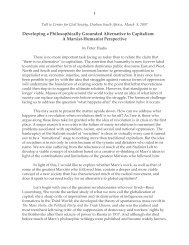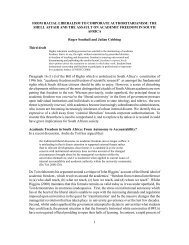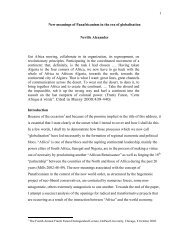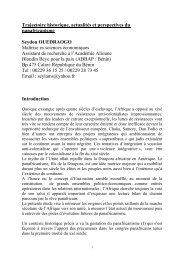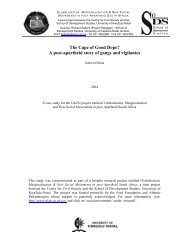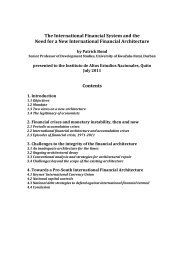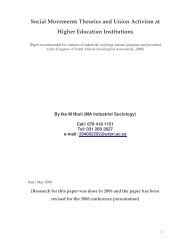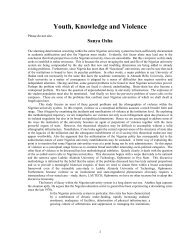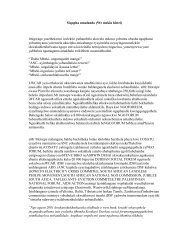April 2011 - Centre for Civil Society - University of KwaZulu-Natal
April 2011 - Centre for Civil Society - University of KwaZulu-Natal
April 2011 - Centre for Civil Society - University of KwaZulu-Natal
Create successful ePaper yourself
Turn your PDF publications into a flip-book with our unique Google optimized e-Paper software.
The last 30 years have seen a rapid increase in the amounts <strong>of</strong> speculative<br />
capital flowing around the global capital markets, which has placed<br />
another weapon in the armoury <strong>of</strong> the capitalist class. The globalisation <strong>of</strong><br />
capital places pressure on all capitalist states to deregulate labour markets<br />
and facilitate cuts in labour costs. Attempts to radically alter the structure<br />
<strong>of</strong> UK capital markets as part <strong>of</strong> a re<strong>for</strong>mist agenda would risk provoking a<br />
rapid outflow <strong>of</strong> capital, something the domestic state is never going to<br />
allow.<br />
The prospects <strong>for</strong> effective resistance to casualisation there<strong>for</strong>e do not lie<br />
in abstract campaigns intended to put pressure on the state to legislate<br />
against the bosses’ interests. There are three main strategies that may<br />
hold some promise.<br />
Worker-Run Temping Agencies<br />
One possible model <strong>for</strong> mitigating the effects <strong>of</strong> casualisation is <strong>for</strong><br />
workers to set up their own agencies, outside the control <strong>of</strong> the capitalist<br />
class. It has been suggested that these could be directly run by unions. In a<br />
mature economy with intense internal competition, companies mainly<br />
concerned with reducing costs could respond well to an agency able to<br />
provide workers at or below the cost <strong>of</strong> workers from other agencies. A cooperatively<br />
managed agency would have much lower overheads than a<br />
private-sector equivalent [this can work where income has been<br />
traditionally low like actors and artists/designers, but didn’t have much<br />
appeal when the ex-dockers tried to promote this idea amongst their<br />
members] being able to provide higher direct wages and benefits to its<br />
workers and possibly providing a site <strong>of</strong> political re-composition.<br />
There are historical precedents <strong>for</strong> this. The beginnings <strong>of</strong> the labour<br />
movement in Italy saw the <strong>for</strong>mation <strong>of</strong> labour cooperatives amongst<br />
agricultural workers, which resurfaced in the movement <strong>of</strong> the Italian<br />
“organised unemployed” in the 80s. Similarly, the early French syndicalists<br />
set up (or more accurately took over) the “Bourse de Travails”- labour<br />
exchanges that provided a <strong>for</strong>um <strong>for</strong> political agitation.<br />
Aside from the distaste engendered in contemplating managing our own<br />
exploitation, there are issues associated with entering into competition<br />
with capitalist enterprises. One <strong>of</strong> the factors that caused the co-operative<br />
movement to fail was that it was subject to all the same pressures as<br />
traditional business. Over time hierarchy and bureaucracy developed and<br />
the radicalism ebbed. For a union to take on such a role may exacerbate<br />
the contradiction already implicit within what Negri calls “its traditional<br />
function as half-party and half-merchandise”. However, the class struggle<br />
must take precedence over squeamishness: the question is whether these<br />
<strong>for</strong>ms would help or hinder the self-organising <strong>of</strong> casualised workers.<br />
The Development Of New Subjectivities<br />
Some initiatives have accepted the new terrain <strong>of</strong> atomisation and are<br />
seeking to develop a collective identity based on the shared experience <strong>of</strong><br />
casualised work. The idea seems to be to attempt to develop a classconsciousness<br />
based not on proximity to other workers but on the insecure<br />
conditions experienced by temporary workers. Apart from the use <strong>of</strong><br />
wanky rhetoric like “existential precarity”, my personal opinion is that this<br />
project is <strong>of</strong> limited usefulness beyond raising the pr<strong>of</strong>ile <strong>of</strong> casualised<br />
workers.<br />
Restoring the ties that bind<br />
As described in the previous section, there has been a long-term shift in<br />
hiring practices by the business class. As the <strong>for</strong>m <strong>of</strong> the labour commodity<br />
changes, the organisational <strong>for</strong>ms that struggle take must also change.



